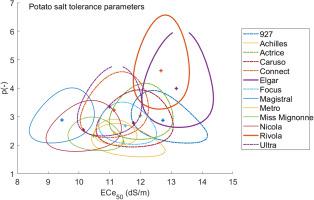Agricultural Water Management ( IF 6.7 ) Pub Date : 2021-04-12 , DOI: 10.1016/j.agwat.2021.106902 G. van Straten , B. Bruning , A.C. de Vos , A. Parra González , J. Rozema , P.M. van Bodegom

|
Having salt-tolerant potatoes is of paramount interest to farmers in salt affected areas, but reliable cultivar-specific parameters on salt tolerance are lacking. To address this issue existing field data on tuber yield on sandy soil at six levels of saline irrigation (0.5, 4, 8, 12, 16, 20 dS m−1) of 13 varieties for which data in two or more consecutive years were available, were analysed year-by-year with the method developed earlier. The method provides estimates of the zero-observed-effect yield (Y0), and two typical salt tolerance parameters, - i.e., a characteristic salinity level and a decline parameter –, as well as information about the uncertainties and correlations between these estimates. The results indicate that all varieties have a similar lethal soil salinity (20–24 dS m−1). However, both yield Y0 as well as salt tolerance parameters differ among cultivars, but for a single variety the estimates vary year by year, and have large uncertainties, underlining the difficulty to obtain robust parameters from single year experiments. The annual variety also hampers the discrimination between varieties. To remedy this, the data from multiple years were united in a single analysis by introducing another – unknown, annually varying - factor that is limiting the yield in the trials. Two ways to describe co-current limitations often used in models were tested. In contrast to the minimum rule, the multiplicative rule is found to provide an acceptable description of the observed yields over all years. This results in a single set of salt tolerance parameters with a narrower uncertainty bound than from single year estimation. It shows that with due account of uncertainties, field tests can be used to identify relatively salt tolerant cultivars, while accounting for between-year yield differences. Most potato cultivars have an ECe90 of about 4–5 dS m−1, but for some it is roughly double, while maintaining good yield, suggesting that these varieties are good candidates for salt adapted agriculture.
中文翻译:

通过多年田间试验估算特定品种的耐盐性模型参数,以鉴定耐盐马铃薯品种
耐盐马铃薯对耐盐地区的农民最为重要,但缺乏可靠的特定品种的耐盐性参数。为了解决这个问题,已有13个品种的六个盐渍灌溉水平(0.5、4、8、12、16、20 dS m -1)在沙质土壤上的块茎产量现有数据,可以连续两年或更长时间获得数据。使用较早开发的方法逐年进行分析。该方法提供了零观测效应产量(Y0)和两个典型的耐盐性参数(即特征性盐度水平和下降参数),以及有关这些估计值之间的不确定性和相关性的信息。结果表明,所有变种的致死土壤盐度都相似(20–24 dS m -1)。但是,两者都产生Y0不同品种的耐盐性以及耐盐性参数也不同,但单个品种的估计值逐年变化,并且不确定性很大,这突出说明了难以从单年实验中获得可靠参数的困难。一年一度的变种也妨碍了变种之间的区别。为了解决这个问题,将多年的数据合并到一个分析中,引入了另一个未知的,每年变化的因素,该因素限制了试验的产量。测试了两种描述模型中经常使用的并流限制的方法。与最小规则相反,发现相乘规则可以提供对所有年份观测到的单产的可接受描述。这样得出的单组耐盐性参数的不确定性范围比单年估算的范围要窄。它表明,由于存在不确定性,可以使用田间试验来确定相对耐盐的品种,同时考虑年间产量差异。大多数马铃薯品种都有ECe 90约为4–5 dS m -1,但对有些而言,大约是两倍,同时保持了良好的产量,这表明这些品种是盐改良农业的良好候选者。

























 京公网安备 11010802027423号
京公网安备 11010802027423号